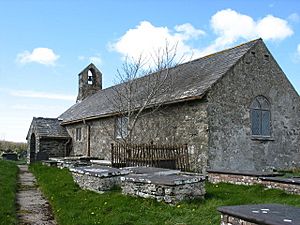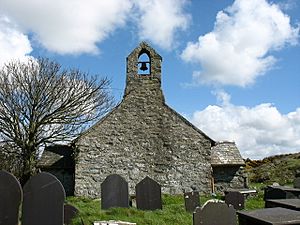St Fflewin's Church, Llanfflewin facts for kids
Quick facts for kids St Fflewin's Church, Llanfflewin |
|
|---|---|

A view from the south-east
|
|
| Lua error in Module:Location_map at line 420: attempt to index field 'wikibase' (a nil value). | |
| OS grid reference | SH 349 890 |
| Location | Llanfflewin, Anglesey |
| Country | Wales |
| Denomination | Church in Wales |
| History | |
| Status | Church |
| Founded | 630 (reputedly) Earliest dateable feature of present building is 18th-century |
| Founder(s) | St Fflewin (reputedly) |
| Dedication | St Fflewin |
| Architecture | |
| Functional status | Active |
| Heritage designation | Grade II |
| Designated | 12 May 1970 |
| Specifications | |
| Length | 47 ft 6 in (14.5 m) |
| Width | 14 ft 9 in (4.5 m) |
| Materials | Rubble masonry |
| Administration | |
| Parish | Llanfechell with Bodewryd with Rhosbeirio with Llanfflewin and Llanbadrig |
| Deanery | Twrcelyn |
| Archdeaconry | Bangor |
| Diocese | Diocese of Bangor |
| Province | Province of Wales |
St Fflewin's Church, Llanfflewin is a small church located in the countryside of Anglesey, Wales. It sits next to a farm. People believe the very first church here was built by St Fflewin in the year 630.
However, the church building you see today was mostly built much later. Its oldest parts are from the 1700s. Even so, it has some older treasures inside. These include a stone font from the 1300s or 1400s. There is also a piece of an old gravestone from the Middle Ages.
This church is still used for worship by the Church in Wales. It is part of a group of five churches. St Fflewin's Church is also a Grade II listed building. This means it is a special building that should be protected. Experts describe it as a "simple rural church built on Medieval foundations."
Contents
History of St Fflewin's Church
Who was St Fflewin?
The church is named after St Fflewin. He was a Christian who lived in the 500s. He is said to have come from a place called Armorica, which is now part of northern France. St Fflewin is believed to have started a Christian site here in 630.
Early Church Buildings
Records show there was a church on this spot by 1254. However, none of the very old buildings survive today. The current church building likely stands on the foundations of earlier churches. The oldest parts of the building we see now are from the late 1700s.
Changes Over Time
St Fflewin's Church has been repaired and rebuilt several times. It had some work done in the early 1800s. Then, in 1864, it was partly rebuilt again. More restoration work happened in the 1930s.
A famous Welsh poet and clergyman, Morris Williams, was the rector (the main priest) here. He served the church from 1859 until he passed away in 1874.
Where is the Church Located?
The church is in a quiet, rural area in north Anglesey. It is about one mile from a village called Llanrhuddlad. The name Llanfflewin comes from the Welsh word llan. This word originally meant "enclosure" and later came to mean "church." So, Llanfflewin means "Church of Fflewin."
The church is surrounded by a raised, circular area. It has an arched gate called a lychgate, which might be from the 1600s. St Fflewin's Church is still an active place of worship today.
Architecture and Features
Church Design
St Fflewin's Church is small and shaped like a rectangle. Inside, there is no wall separating the main seating area (the nave) from the altar area (the chancel). The church is about 47 feet long and 14 feet wide.
It is built from rubble masonry, which means it uses rough, uneven stones. The roof is made of slate. At the west end of the roof, there is a small, pointed structure called a bellcote where the church bell hangs. Inside, you can see the wooden beams that support the roof.
Entrances and Rooms
You enter the church through a porch on the south side. This porch has a rounded archway. On the north side, at the west end, there is a small room called a vestry. This room has one window.
Windows and Ancient Stones
The windows on the south and north walls are rectangular and come in pairs. The window on the east wall is rounded at the top and has two sections.
An interesting feature is the windowsill of the east window. It has a piece of a medieval gravestone set into it. This stone is from after the year 1300. It has an inscription that says HIC IACET MADOCUS, which means "Here lies Madoc."
Inside the Church
The church has a unique, nine-sided font. A font is a basin used for baptisms. This one is made of roughly shaped stone and dates back to the 1300s or 1400s.
You can also see several slate memorial tablets on the walls. These are from the 1700s. In the past, the church also had a bier (a frame for carrying a coffin) from 1784. There was also an old silver cup with a lid from the 1500s. Other old items included a wooden pitch pipe (used to set the musical pitch) and a wooden shovel, both from the late 1700s.
Why is it a Special Building?
St Fflewin's Church is officially recognized as a special building. It is a Grade II listed building. This status means it is important and efforts should be made to protect it. It received this status on May 12, 1970.
It is listed because it is a "simple rural church built on Medieval foundations." Experts also note that it keeps the traditional look of churches built before the Gothic Revival style became popular.
People who have visited the church have often described it as a beautiful and interesting place. One writer in the 1800s called it a "plain edifice" that was "beautifully situated near a small lake." Another visitor in 1867 noted its "singular design" font and described the location as "wild and striking." Today, it is still considered a "typical, well-preserved rural church" and is worth a visit.


